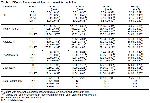High-concentrate diets often contain high levels of fermentable carbohydrate and low levels of fiber to maximize energy intake. Feeding a diet with low NDF content or large changes in dietary composition often result in a higher relative risk of SARA. Ration formulation totally involves a balance between acid and buffer production. The results of some studies
11,12 have shown the effectiveness of acarbose at controlling pH under conditions of SARA. Similarly, in the present study, administration of acarbose has consistently increased ruminal pH (P<0.05) in all groups immediately after feeding, on h 4, 8 and 12 when compared to control group. It was reported that, the increased ruminal pH was associated with the effect of acarbose on slowing the rate of degradation of starch to glucose, thereby reducing the rate of VFA production
4. Also it was determined in the present study that, the doses of 2 or 3 mg acarbose were more efficacious than 1 mg dose of acarbose to prevent SARA. Because, ruminal pH levels were found to be statistically higher in groups 2 and 3 than group 1 (P<0.05). In the current study, total VFA and molar percentages of propionate and butyrate increased (P<0.05), whereas percentage of acetate decreased (P<0.05) due to acarbose addition when compared with control group. These responses are similar to those reported by McLaughlin et al.
4 and Nagaraja et al.
22. When rumen pH is maintained at a higher level, than rate of rumen VFA production tends to reduce. Similar to the ruminal pH, administration doses of 2 or 3 mg acarbose were found to be statistically more efficacious (P<0.05) than 1 mg dose of acarbose on reducing total VFA under conditions of SARA. Also, the molar percentages of propionate and butyrate for the cows in all treatment groups were higher than controls (P<0.05). This is because of the effect of acarbose on reducing glucose availability
23. These results are expected because supplemental acarbose stimulates the presence of lactic acid-utilizing bacteria, which produce propionate. Differences for molar percentages of propionate, butyrate and acetate in acarbose administrated groups were noted between prefeeding (0 h) and postfeeding (4, 8, 12 h) sampling times, but no differences occurred between 4, 8 and 12 h postfeeding. In general, lactate levels do not increase markedly until the pH drops below 5.2
10. In the present study, prefeeding lactate levels were between 18-23 nM in the groups but after acarbose administration, ruminal levels of lactate were extremely low and below the level of detection (< 1 nM).
Animals respond to trauma, tissue injury, or infection by activating the acute phase response24. This response includes the production of APPs, such as SAA and Hp in the liver24. Hence, an elevation at Hp and SAA levels was previously suggested as useful parameters for controlling SARA13,15,16. Grain-induced SARA increased the concentrations of both SAA and Hp in peripheral blood of steers, albeit that the increase in Hp was greater in steers that had been adapted to a 60% concentrate diet than in steers that received an all forage diets before the SARA induction25,26. Studies by Gozho et al.27 and Khafipoor et al.28 showed that grain-induced SARA also increased SAA in lactating dairy cows. In the current study, prefeeding serum levels of Hp and SAA were statistically higher in all groups (P<0.05) due to SARA. After administration of acarbose, the decreases in serum Hp and SAA levels were found to be statistically significant (P<0.05) when compared with controls. This significant drop in APPs in the present study shows that, acarbose might be very effective in activating the repair process necessary to return the organism to normal function.
As a conclusion, supplementing the diet of dairy cows, especially at the doses of 2 or 3 mg of acarbose/kg of BW improved ruminal function and accelerated the repair process of the organism and had strong effects on reducing incidence of SARA. But it is obvious that, control of fiber-content and ration quality is more effective and less expensive than the use of α-amylase and glucosidase inhibitors.





